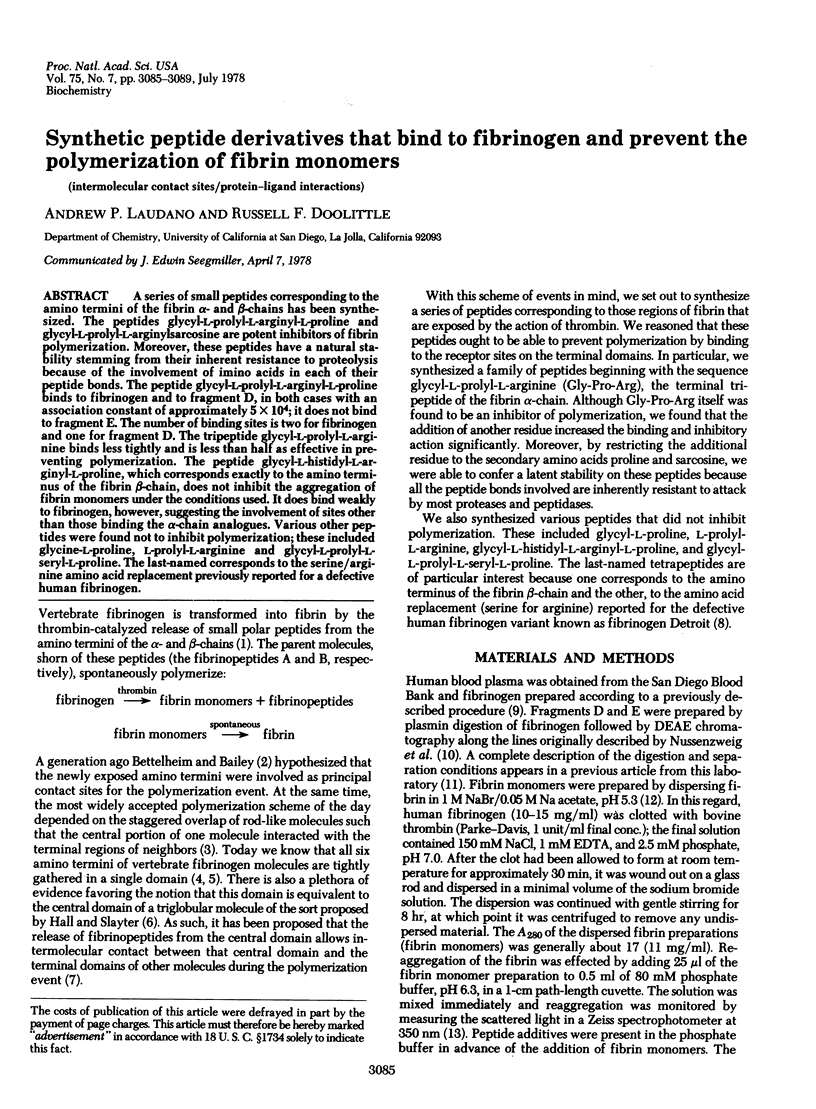Abstract
A series of small peptides corresponding to the amino termini of the fibrin α- and β-chains has been synthesized. The peptides glycyl-L-prolyl-L-arginyl-L-proline and glycyl-L-prolyl-L-arginylsarcosine are potent inhibitors of fibrin polymerization. Moreover, these peptides have a natural stability stemming from their inherent resistance to proteolysis because of the involvement of amino acids in each of their peptide bonds. The peptide glycyl-L-prolyl-L-arginyl-L-proline binds to fibrinogen and to fragment D, in both cases with an association constant of approximately 5 × 104; it does not bind to fragment E. The number of binding sites is two for fibrinogen and one for fragment D. The tripeptide glycyl-L-prolyl-L-arginine binds less tightly and is less than half as effective in preventing polymerization. The peptide glycyl-L-histidyl-L-arginyl-L-proline, which corresponds exactly to the amino terminus of the fibrin β-chain, does not inhibit the aggregation of fibrin monomers under the conditions used. It does bind weakly to fibrinogen, however, suggesting the involvement of sites other than those binding the α-chain analogues. Various other peptides were found not to inhibit polymerization; these included glycine-L-proline, L-prolyl-L-arginine and glycyl-L-prolyl-L-seryl-L-proline. The last-named corresponds to the serine/arginine amino acid replacement previously reported for a defective human fibrinogen.
Keywords: intermolecular contact sites, protein-ligand interactions
Full text
PDF




Selected References
These references are in PubMed. This may not be the complete list of references from this article.
- BAILEY K., BETTELHEIM F. R., LORAND L., MIDDLEBROOK W. R. Action of thrombin in the clotting of fibrinogen. Nature. 1951 Feb 10;167(4241):233–234. doi: 10.1038/167233a0. [DOI] [PubMed] [Google Scholar]
- BETTELHEIM F. R., BAILEY K. The products of the action of thrombin on fibrinogen. Biochim Biophys Acta. 1952 Nov;9(5):578–579. doi: 10.1016/0006-3002(52)90213-8. [DOI] [PubMed] [Google Scholar]
- Birken S., Wilner G. D., Canfield R. E. Studies of the structure of canine fibrinogen. Thromb Res. 1975 Oct;7(4):599–610. doi: 10.1016/0049-3848(75)90106-1. [DOI] [PubMed] [Google Scholar]
- Blombäck B., Blombäck M., Henschen A., Hessel B., Iwanaga S., Woods K. R. N-terminal disulphide knot of human fibrinogen. Nature. 1968 Apr 13;218(5137):130–134. doi: 10.1038/218130a0. [DOI] [PubMed] [Google Scholar]
- Blombäck B., Blombäck M. The molecular structure of fibrinogen. Ann N Y Acad Sci. 1972 Dec 8;202:77–97. doi: 10.1111/j.1749-6632.1972.tb16323.x. [DOI] [PubMed] [Google Scholar]
- Blombäck M., Blombäck B., Mammen E. F., Prasad A. S. Fibrinogen Detroit--a molecular defect in the N-terminal disulphide knot of human fibrinogen? Nature. 1968 Apr 13;218(5137):134–137. doi: 10.1038/218134a0. [DOI] [PubMed] [Google Scholar]
- Cottrell B. A., Doolittle R. F. Amino acid sequences of lamprey fibrinopeptides A and B and characterizations of the junctions split by lamprey and mammalian thrombins. Biochim Biophys Acta. 1976 Dec 22;453(2):426–438. doi: 10.1016/0005-2795(76)90138-0. [DOI] [PubMed] [Google Scholar]
- DONNELLY T. H., LASKOWSKI M., Jr, NOTLEY N., SCHERAGA H. A. Equilibria in the fibrinogen-fibrin conversion. II. Reversibility of the polymerization steps. Arch Biochem Biophys. 1955 Jun;56(2):369–387. doi: 10.1016/0003-9861(55)90258-7. [DOI] [PubMed] [Google Scholar]
- DOOLITTLE R. F. DIFFERENCES IN THE CLOTTING OF LAMPREY FIBRINOGEN BY LAMPREY AND BOVINE THROMBINS. Biochem J. 1965 Mar;94:735–741. doi: 10.1042/bj0940735. [DOI] [PMC free article] [PubMed] [Google Scholar]
- Doolittle R. F., Cassman K. G., Cottrell B. A., Friezner S. J., Takagi T. Amino acid sequence studies on the alpha chain of human fibrinogen. Covalent structure of the alpha-chain portion of fragment D. Biochemistry. 1977 Apr 19;16(8):1710–1715. doi: 10.1021/bi00627a029. [DOI] [PubMed] [Google Scholar]
- Doolittle R. F., Schubert D., Schwartz S. A. Amino acid sequence studies on artiodactyl fibrinopeptides. I. Dromedary camel, mule deer, and cape buffalo. Arch Biochem Biophys. 1967 Feb;118(2):456–467. doi: 10.1016/0003-9861(67)90374-8. [DOI] [PubMed] [Google Scholar]
- Doolittle R. F. Structural aspects of the fibrinogen to fibrin conversion. Adv Protein Chem. 1973;27:1–109. doi: 10.1016/s0065-3233(08)60446-5. [DOI] [PubMed] [Google Scholar]
- HALL C. E., SLAYTER H. S. The fibrinogen molecule: its size, shape, and mode of polymerization. J Biophys Biochem Cytol. 1959 Jan 25;5(1):11–16. doi: 10.1083/jcb.5.1.11. [DOI] [PMC free article] [PubMed] [Google Scholar]
- Iwanaga S., Wallén P., Gröndahl N. J., Henschan A., Blombäck B. Isolation and characterization of N-terminal fragments obtained by plasmin digestion of human fibrinogen. Biochim Biophys Acta. 1967 Dec 12;147(3):606–609. doi: 10.1016/0005-2795(67)90025-6. [DOI] [PubMed] [Google Scholar]
- Kudryk B. J., Collen D., Woods K. R., Blombäck B. Evidence for localization of polymerization sites in fibrinogen. J Biol Chem. 1974 May 25;249(10):3322–3325. [PubMed] [Google Scholar]
- LATALLO Z. S., FLETCHER A. P., ALKJAERSIG N., SHERRY S. Influence of pH, ionic strength, neutral ions, and thrombin on fibrin polymerization. Am J Physiol. 1962 Apr;202:675–680. doi: 10.1152/ajplegacy.1962.202.4.675. [DOI] [PubMed] [Google Scholar]
- Mammen E. F., Prasad A. S., Barnhart M. I., Au C. C. Congenital dysfibrinogenemia: fibrinogen Detroit. J Clin Invest. 1969 Feb;48(2):235–249. doi: 10.1172/JCI105980. [DOI] [PMC free article] [PubMed] [Google Scholar]
- Marder V. J. Identification and purification of fibrinogen degradation products produced by plasmin: considerations on the structure of fibrinogen. Scand J Haematol Suppl. 1971;13:21–36. doi: 10.1111/j.1600-0609.1971.tb01981.x. [DOI] [PubMed] [Google Scholar]
- Marder V. J., Shulman N. R., Carroll W. R. High molecular weight derivatives of human fibrinogen produced by plasmin. I. Physicochemical and immunological characterization. J Biol Chem. 1969 Apr 25;244(8):2111–2119. [PubMed] [Google Scholar]
- Murano G., Walz D., Williams L., Pindyck J., Mosesson M. W. Primary structure of the amino terminal regions of chicken fibrin chains. Thromb Res. 1977 Jul;11(1):1–10. doi: 10.1016/0049-3848(77)90063-9. [DOI] [PubMed] [Google Scholar]
- NUSSENZWEIG V., SELIGMANN M., PELMONT J., GRABAR P. [The products of degradation of human fibrinogen by plasmin. I. Separation and physicochemical properties]. Ann Inst Pasteur (Paris) 1961 Mar;100:377–389. [PubMed] [Google Scholar]
- Takagi T., Doolittle R. F. Amino acid sequence studies on plasmin-derived fragments of human fibrinogen: amino-terminal sequences of intermediate and terminal fragments. Biochemistry. 1975 Mar 11;14(5):940–946. doi: 10.1021/bi00676a010. [DOI] [PubMed] [Google Scholar]
- WOFSY L., METZGER H., SINGER S. J. Affinity labeling-a general method for labeling the active sites of antibody and enzyme molecules. Biochemistry. 1962 Nov;1:1031–1039. doi: 10.1021/bi00912a013. [DOI] [PubMed] [Google Scholar]
- Weinstein M. J., Doolittle R. F. Differential specificities of the thrombin, plasmin and trypsin with regard to synthetic and natural substrates and inhibitors. Biochim Biophys Acta. 1972 Feb 28;258(2):577–590. doi: 10.1016/0005-2744(72)90250-1. [DOI] [PubMed] [Google Scholar]


